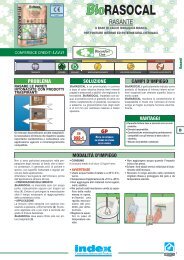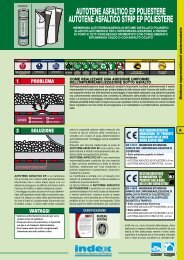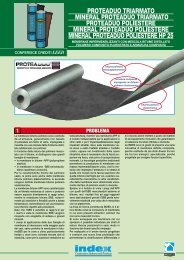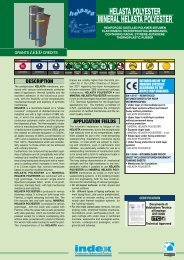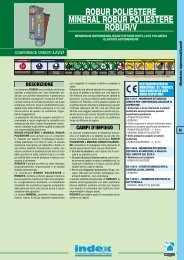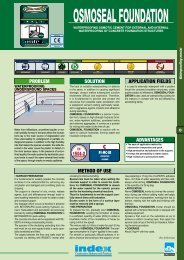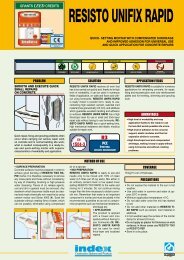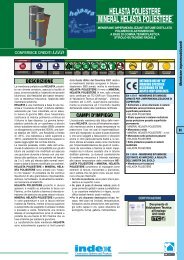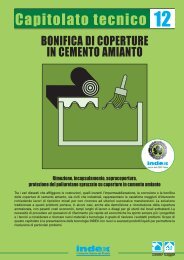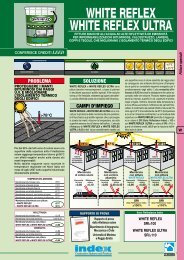Technical Specifications - Index S.p.A.
Technical Specifications - Index S.p.A.
Technical Specifications - Index S.p.A.
Create successful ePaper yourself
Turn your PDF publications into a flip-book with our unique Google optimized e-Paper software.
LAYING DETAILS<br />
On the covering of the TGV tunnel there is a transversal joint every<br />
9-10 m. Across each joint an aluminum plate 20÷25 cm in width was<br />
laid, nailed on side only. The waterproofing layer then covered the joint.<br />
Waterproof covering<br />
Flat joint<br />
(TGV-Atlantique)<br />
Primer<br />
Sheet<br />
metal<br />
Connection<br />
between vertical<br />
waterproof<br />
covering<br />
(TGV-Atlantique)<br />
The MINERAL TESTUDO sheet for the end area running for 40÷50 cm<br />
on the vertical part was not bonded but covered the end of the non<br />
woven filtering fabric.<br />
TESTUDO<br />
MINERAL TESTUDO<br />
Free area<br />
A strip of TESTUDO SPUNBOND 25, 25÷30 cm wide was torch<br />
bonded to the joining lines of the vertical lining panels, while a strip of<br />
the same material about 50 cm in width was bonded across the joining<br />
line in contact with the vertical panels as well as the horizontal beam<br />
of the excavation foot.<br />
Primer<br />
Primer<br />
TESTUDO<br />
Vertical draining layer<br />
Sheets made of non woven draining fabric about 2 cm thick coupled with a non woven filtering fabric sized about 150 gr/<br />
m 2 were mechanically fixed at the top and on one side, all the way down to cover the drainpipe.<br />
Pontage of the<br />
panel joining lines<br />
Drainpipes<br />
On the TGV tunnels, drainpipes were used with transversal cracks, while in the tunnel for the underground system, porous<br />
pipes made of cement conglomerate were used.<br />
Protection in the backfill phases<br />
1÷2 cm panels made of compressed cellulosic fibre were installed to<br />
protect the part of the vertical covering of the TGV tunnel before the<br />
backfill operations.<br />
Waterproof<br />
covering<br />
• Backfill operation<br />
Although the membranes used have an extremely high resistance to<br />
puncture, the backfill operations must be carried out carefully, making<br />
sure that the dumper always rests on the ground it pushes forward, by<br />
using first the earth without large stones, onto which the site mixed<br />
pebbles can be used; it is always advisable to apply a layer to the<br />
vertical parts covered with the waterproofing cover for protection and<br />
mechanical protection purposes. If only the mechanical protection is<br />
required, panels of expanded polystyrene or compressed fibres can<br />
be used.<br />
Protection<br />
Ground<br />
6<br />
TUNNELS<br />
<strong>Technical</strong> <strong>Specifications</strong>



